
We may earn revenue from product links on this page and participate in affiliate programs. Learn More ›

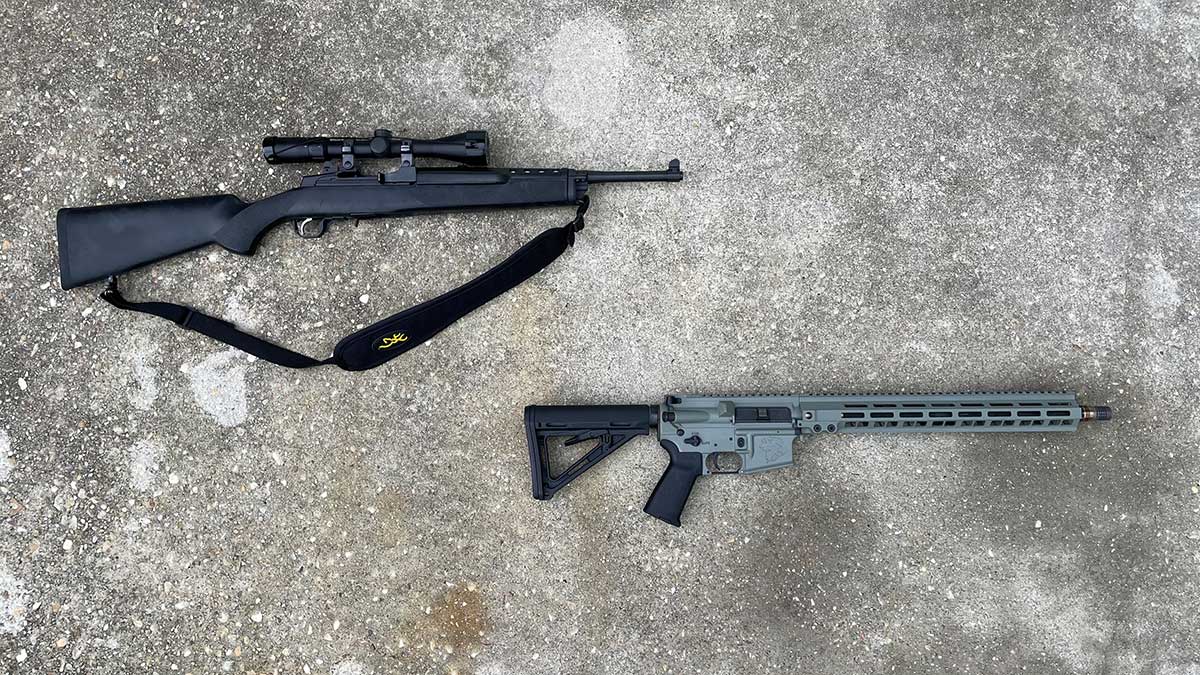
The Ruger Mini 14 vs the AR-15 is a classic age old comparison of the two 5.56 rifles.
We may earn revenue from product links on this page and participate in affiliate programs. Learn More ›
Since their inception, many people have compared the Ruger Mini 14 vs AR-15 to determine the better gun for their needs. Both of these firearms are based on other larger platforms that originally started in .308 or 7.62 NATO.
The AR-15 is a scaled-down variant of the AR-10 designed by Eugene Stoner and James Sullivan. While the Ruger Mini-14 is a scaled-down version of the M-14, which gets its roots from the M1 Garand.
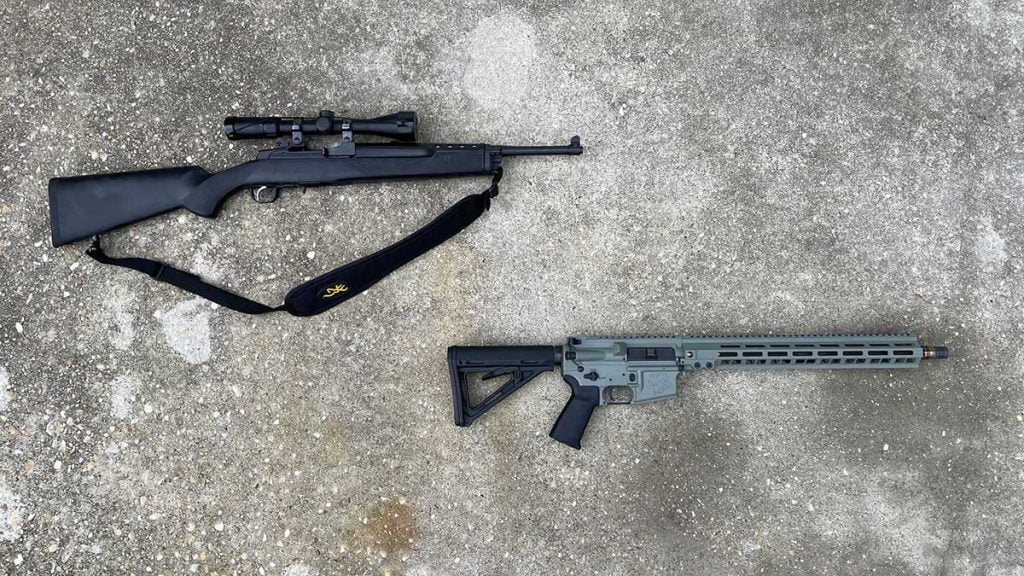
These guns share a common lineage in that James Sullivan was also a designer on the Mini-14 under Bill Ruger.
While these guns both have similar beginnings and they share a designer, they are about as different as they can get.
The AR-15 has been around since the late ’50s and the Mini-14 platform since the early ’70s.
Both the Ruger Mini 14 and the AR-15 have had decades for their designs to be refined.
The Ruger Mini-14 found a lot of use in police service and some limited use with foreign militaries.
At the same time, the AR-15 became one of the most popular military firearms in the entire world, eclipsed only by the AK-47.
Right off the bat, looking at these two firearms, you’re not likely to get them confused.
The Mini-14 is normally in a wood stock and has that old-world look, while the AR-15 looks somewhat futuristic.
The guns look drastically different, and they operate quite differently with completely different ergonomics.


Both of these guns are fairly versatile and can suit various roles, although the AR-15 is much more versatile due to its modularity and variety of options.
Ruger is the only manufacturer of the Ruger Mini-14, and they have always been the only manufacturer.
AR-15’s and their components are manufactured by likely over 100 different companies in the U.S. alone.
That’s only talking about companies that build complete rifles. There are a variety of other companies that make aftermarket parts.
You can build an AR-15 in almost any format that you would like. Most AR-15’s have barrels that range from 7.5 to 20 inches, although you can get variants with barrels as short as five, and I’ve seen variants with barrels as long as 24.
The Ruger Mini-14’s are currently produced with 16″ and 18.5″ barrels. Previously there were versions of the Mini with a 20″ barrel.
When it comes to pretty much any part on the Ruger Mini-14, you’re going to be stuck with Ruger parts, minus magazines and aftermarket stocks.
For the AR-15, you can get barrels, bolts, trigger groups, receivers, furniture, and every small part imaginable on the firearm.
If you have a local gunsmith, it’s a guarantee they will have all the tools required to disassemble and take down an AR-15 and each component completely.
If something goes wrong with your Ruger Mini-14, they may be able to fix it, or you may have to send the gun off to Ruger.
With this vast amount of parts, support, and options for the AR-15, you have a much wider variety of roles.
Not only can you get a variety of barrel lengths, but you can also get a variety of calibers.
The Mini-14 is available in .223/5.56, 300 Blackout, and 7.62×39.
If you’re shooting an older Mini-14, be careful as a lot of those were chambered for .223 and do not take 5.56 Ammunition. The AR-15, on the other hand, has 22-caliber conversion kits.
Most of them ship in 5.56, but there is also a wide variety of other calibers, such as 300 Blackout, 6.5 Grendel, 7.62 NATO, 6mm ARC, 450 Bushmaster, .50 Beowulf, and there are a lot more calibers that haven’t reached that level of commercial success.
So right off the bat, you’re going to have to give a win to the AR-15 regarding versatility and just options.
The Ruger Mini-14 Ranch Rifle, as it’s named, was designed as a tractor gun or a gun that a rancher or farmer would keep in their truck, their tractor, their bulldozer, or whatever piece of equipment they were driving. They could then grab and shoot a varmint like a coyote to keep them away from their cattle or livestock. It’s a versatile, handy rifle that you were meant to have with you at all times.
The AR-15, on the other hand, was also originally designed for sporting purposes. But it wasn’t marketed quite in that manner. The original AR-15 had a 20-inch barrel. It made it a little bit long and unwieldy if you compare it to the 18.5-inch barrel on the Mini-14.
But today, we no longer have those limitations. You can find AR-15’s with 14.5 pin weld barrels, 16-inch barrels, or AR pistols with 12.5, 8-inch barrels, etc.
Almost any length barrel you can imagine, making the gun even handier and lighter than the Mini-14.
As you can see above in the size chart, there are various weights for the AR-15. At the end of the day, you could use the Mini-14 for hunting, home defense, a truck gun, or about anything the AR-15 will do. But the AR-15 can get a little more specialized than the Mini.


Ergonomically, these guns are as different as can be. One is set up more like a traditional rifle while the other is a lot more modern.
The stocks on these guns take a drastically different approach.
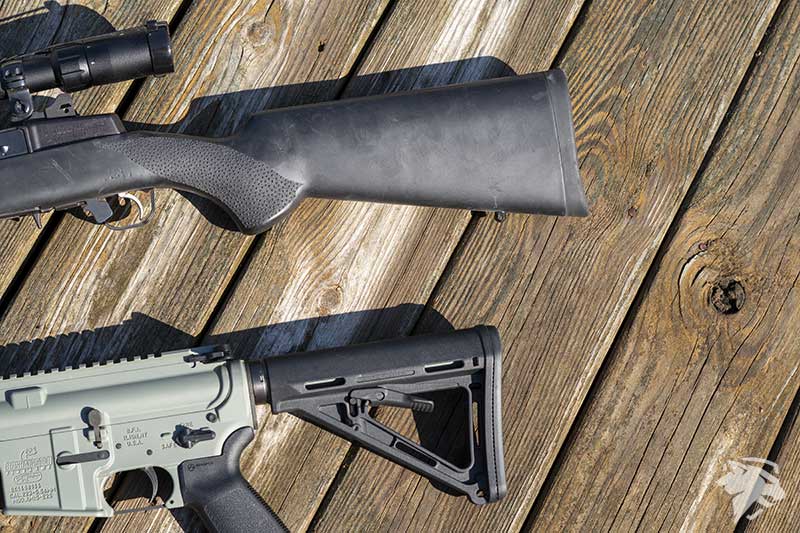
With an AR-15, most of your stocks will be adjustable. This means you can adjust the length of the pull depending on what you’re doing.
If you want a shorter length of pull for a smaller stature person, or if you’re wearing a plate carrier, the AR-15 stock will usually allow this to happen.
You can also get fixed stocks for your AR-15 as well. These fixed stocks are available in various sizes, so you can find a length of pull that best suits your needs.
The Mini-14, on the other hand, has a couple of aftermarket tactical options that allow for a folding stock and add Picatinny to the gun. Most of the factory options are going to be a wooden or a laminate stock that is fixed.
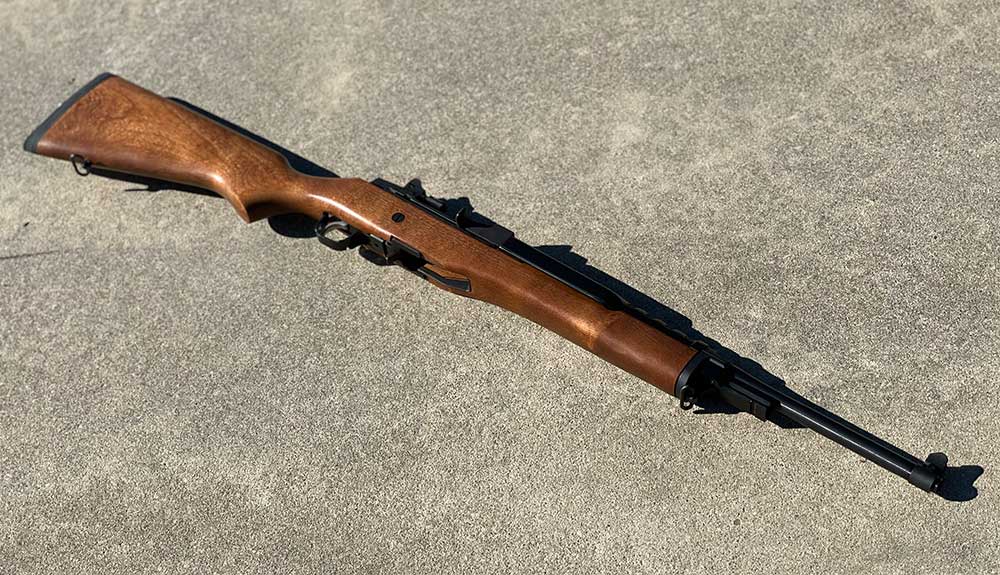
These stocks tend to have a very long length of pull, and unfortunately, there aren’t many aftermarket options that allow for a shorter length of pull.
Between these two guns, the biggest downside of the Mini, in my opinion, is the length of pull on the stock.
The mini is designed to shoot in a bladed stance, while with the AR-15 you can shoot with a bladed stance or a more squared-up stance, depending on the stock you use.
The grips of these pistols are wildly different but are there for the same purpose, to grip and hold the gun effectively.
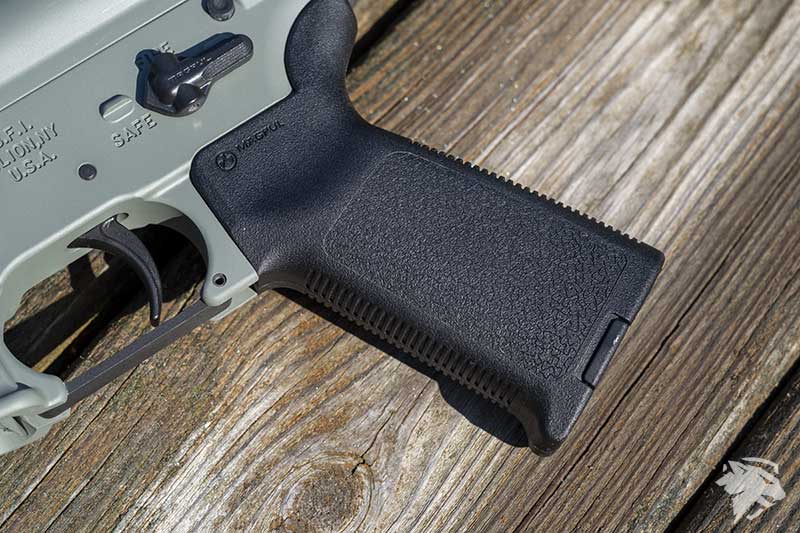
The AR-15 has a pistol grip that attaches via a screw at the lower part of the receiver.
This pistol grip is interchangeable and can be switched out to a variety of different options. Almost every company you can imagine makes a different pistol grip for the AR-15, so you can really tailor it to your hand and what you want.
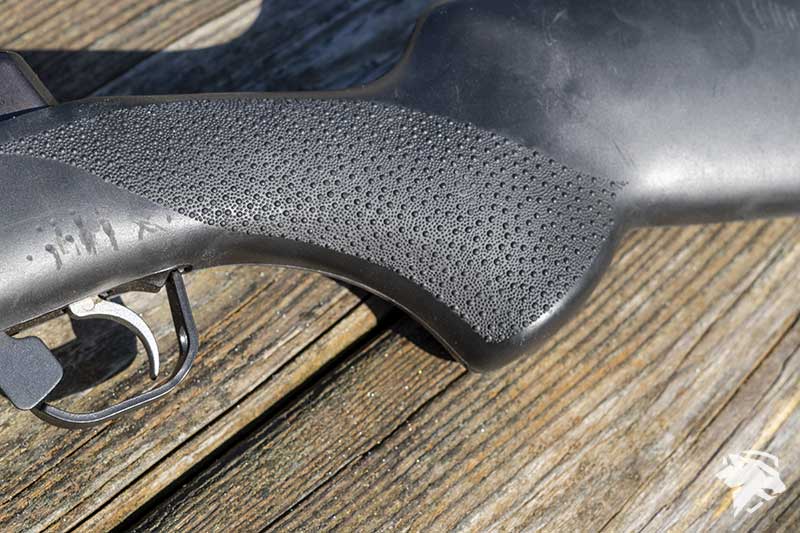
The grip on the Mini-14 is integrated into the stock itself and it is not a pistol grip.
Some chassis have a pistol-style grip, but it really just depends on what you’re looking for.
Personally, I like the ergonomics of the grip on the Mini-14, and I also like the ergonomics of the grip on the AR-15.
They’re both different, and it just really depends on what you’re looking for. If you want something more traditional, go with the Mini, whereas if you want something more modern, go with the AR. Neither is better or worse than the other.


Here’s another area where the design of this gun will be drastically different.
The safety on an AR-15 is a small lever on the left-hand side of the firearm that you can sweep off with your firing thumb by rotating it 90 degrees. That is in the standard mil-spec format.
There is a variety of aftermarket and ambidextrous options to get shorter levers, longer levers, fatter levers, thinner levers, low-profile levers, etc.
You can get an AR-15 safety setup almost any way you want it. It’s easy to use for both right and left-handed shooters, and it’s very intuitive.
The AR-15 safety is the safety by which all other firearm safeties are judged.
It has become the gold standard of safeties on firearms. Nearly all modern rifles have been copying the AR-15-style safety.
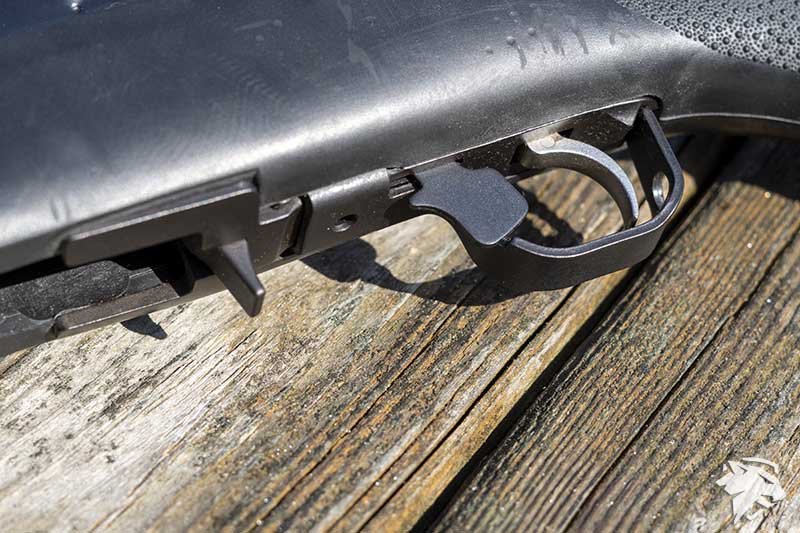
The Mini-14 safety is drastically different from the AR-15.
It’s a piece of sheet metal on the left-hand side of the trigger guard that you must push forward to disengage, and then you wrap your finger around the front of the trigger guard and pull back to place that same sheet metal back in the safe position.
Many people are a little bit sketchy about putting their finger inside the trigger guard to disengage the safety, and I understand where they’re coming from.
One thing I will say is the safety of the Mini-14 is intuitive, but I don’t think anybody can make an argument that it’s better than the AR-15.
Both of these safeties seem secure and they are not likely to come off inadvertently.
That said, the AR-15 safety is definitely far superior to the Mini-14.
The trigger on both these guns is fairly similar in their original formats.
The AR-15 has a bunch of aftermarket triggers. These triggers are very well done and are worlds above anything available for the Mini-14.
That said, in their standard format, the AR-15 trigger tends to be slightly lighter than the Mini-14, but their characteristics are about the same.
You have a little bit of take-up before the trigger breaks, and they tend to have a rolling break. The reset is authoritative and easy to use.
That’s really all you can say about the triggers on both of these guns.
They’re plain mil spec-style triggers. If you want a Gucci trigger, you’re definitely going to want to go with the AR-15. But if you can live with a standard, regular trigger, both of these firearms will suit you in their stock formats.


The bolt release on both of these guns are critical pieces of the operation but function in very different ways.
There’s a ping-pong-style bolt release on the AR-15 situated on the left-hand side of the firearm.
A lot of the new, more modern AR-15 now has an ambidextrous bolt release, but your standard mil-spec gun only has it on the left-hand side.
You can access that with your thumb when you’re going to reload a fresh magazine into the AR-15.
This release can also be used as a bolt hold open if you need to lock the bolt back to the rear manually.
The magazine follower will press this up after you’ve shot your last round out of the gun, but if you need to do it manually, you’ll just want to press the bottom portion of the paddle.
The Mini-14 does not have a bolt release, but it does have a bolt-hold-open feature. As with the AR-15, when the last round is fired, the follower will push up a device to hold the bolt to the rear.
If you want to do this manually, you will need to press down on a little plunger on the left-hand side of the receiver and then pull the bolt back to the rear so it can lock.
It’s small, and it seems like an afterthought, but it does work. It’s not a feature I see most people using often.
The only real reason to use it would be to clear a malfunction. To release the bolt on the Mini-14, you’re going to have to use the charging handle, which I’ll cover next.
The AR-15 has a T-style charging handle located at the rear of the receiver.
The upside of this is it stays out of the way of any accessories you might have mounted on the gun. It’s ambidextrous, from the standpoint that you can easily press it back with both hands if you use both your index finger and middle finger to pull the charging handle back.
The lever to pull it back is only located on the left-hand side, though it’s set up primarily for a right-handed shooter.
There are tons of aftermarket charging handles out there that are truly ambidextrous, as well as ones that are just enhanced.
You can find anything that you’re looking for when it comes to an AR-15-style charging handle.
The Mini has a charging handle similar to the M1 Garand and M14 from which it takes its design cues.
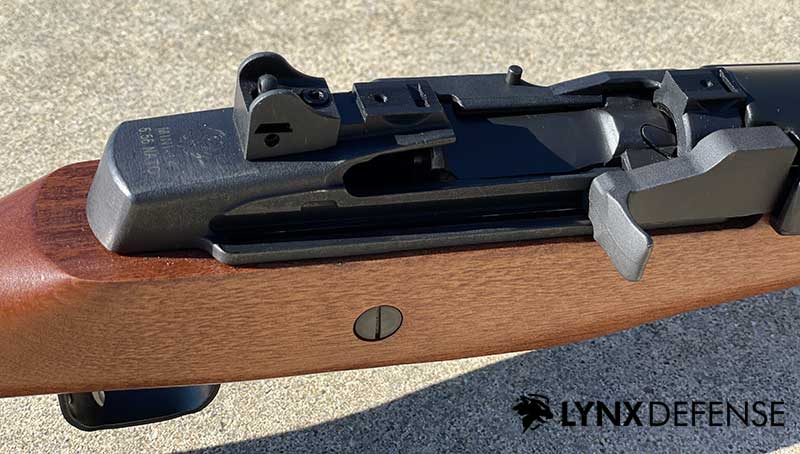
The charging handle is cast metal and it’s located on the right-hand side of the receiver. It is reciprocating and it’s fairly ergonomic.
One issue you might have is if you have an optic mounted on the gun, the charging handle might cause you to drag your finger against the optic when you’re charging the weapon.
This is something you want to keep in mind.
This charging handle has a certain amount of charm about it. There’s something just cool about the way it looks and the way it sounds when you’re charging the weapon.
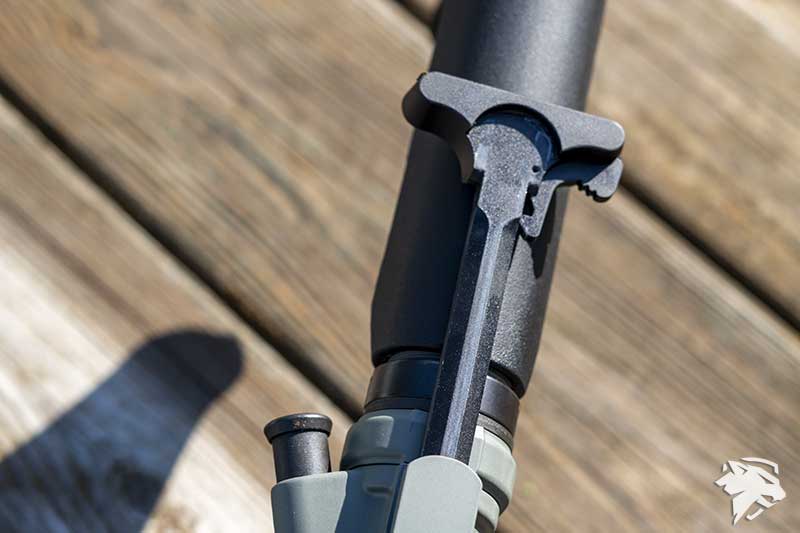
The AR-15 is just a little more boring in this category. That said, the AR-15 is also probably more functional.
It’s similar to driving a brand-new vehicle versus a 1970 pickup.
The 1970s pickup will have a lot more character, but the brand new pickup will have features like Bluetooth that you can hook your smartphone into.
It’s all in what you’re looking for.


The magazine release on these two guns is also very different but serve the same function.
The AR-15 uses a push-button-style magazine release located on the right-hand side of the receiver.
You can reach this with your trigger finger, and the magazine will normally drop free. Again, the downside of the AR-15 is there are so many manufacturers you can’t guarantee that your magazines won’t stick.
But, in general, magazines tend to drop free from an AR-15 lower receiver.
The downsides of this design are, that it can be easy to over-insert a magazine into the AR-15, or the magazine might not actually be locked in place.
It’s common practice to pull down on an AR-15 magazine after inserting it to ensure that it is fully engaged, so you don’t get a false positive when loading the firearm.
The Mini-14 has a magazine release more similar to an AK-47.
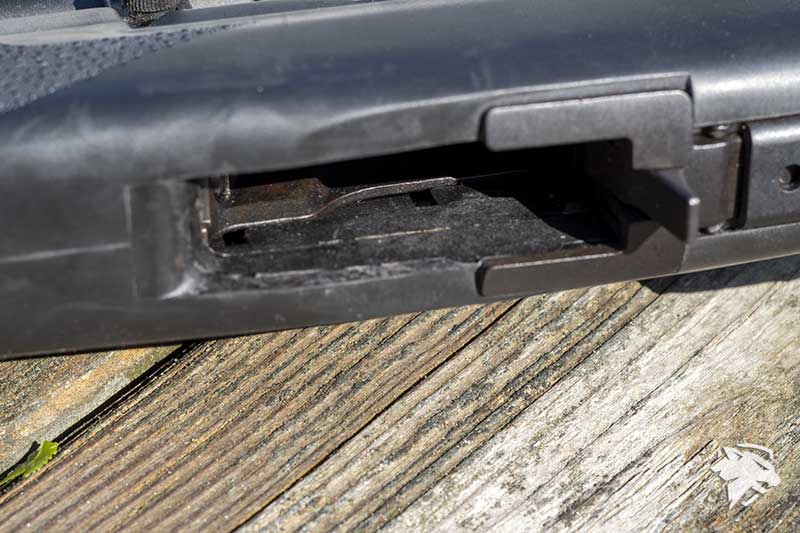
It’s a little lever that sits behind the magazine. It’s a paddle-style release. This release is completely ambidextrous and easy to use for most users.
That said, it’s going to be a lot slower. You have to take your support hand and use your thumb to pull the magazine out of the weapon. Just pressing the paddle release will drop the magazine free in most cases.
That said, ergonomically it just makes sense to grab the magazine and rip it out of the gun.
Quality is a hard subject to discuss.
The main reason is Ruger is the only manufacturer of the Mini-14, while the AR-15 is manufactured by many.
Ruger’s quality of the Mini-14 is good, but it’s not great. It lacks the fit and finish that many AR-15’s have, but it seems durable and reliable.
The parts seem well-made, with a few chintzy things like the sheet metal magazine release or the bolt-hold open plunger.
Some of the things on the gun just seemed cheap. There’s no getting around it.
The AR-15, on the other hand, will vary greatly depending on the AR-15 you buy.
Some of the guns seem like they are complete garbage, while other guns are works of art.
The AR-15 has a vast price range and a large variety of manufacturers who employ different techniques.
Some are built to be the lowest price possible, while others focus on being the most beautiful rifle made.
Other rifles are made specifically to be the lightest gun the manufacturer can produce, and some are built to be the most accurate.
Depending on the AR-15 you buy will depend on the quality you get, whereas the Ruger Mini-14, on average, will be about on par with most AR-15s.
If you’re looking at a Mini-14 and comparing it to an AR-15 in a similar price point, generally, the AR-15 is going to seem a little higher quality.
The stock on the Mini-14 doesn’t seem great. It definitely seems mass manufactured. And as I stated earlier, the fit and finish aren’t great either.
An age-old argument was the AR-15 is not a very reliable weapon, and in some cases that holds true.
The AR-15 definitely had teething issues but, the same can be said for the Ruger Mini-14.
However, f you look at most current production guns made today, they are both very reliable.
If you pick a Mini-14 that is newly manufactured, it’s likely to be very reliable, whereas, with an AR-15, it’s going to be a crapshoot.
Again, having a ton of companies manufacturing the AR-15 opens you up to potential quality-control issues, but if you have a rifle that is equal in quality to the Mini-14, then you’re likely going to have a more reliable firearm with the AR-15.
The reason for this is the system.
The Mini-14 has an open action. That open action could allow a lot of dirt and debris to get into the firearm, whereas the AR-15 is essentially a sealed action.
With the AR-15 the dust cover keeps a lot of stuff out, and even though some modern AR-15s do not have dust covers the system still remains relatively sealed.
Look at the charging handle design and everything about it. The only place for dust and debris to breathe to get into the AR-15 is either really small holes around the charging handle, the trigger opening, or the muzzle itself.
The one big hole that things can get in is the ejection port. The AR-15 bolt sits up really tight against that ejection port and runs straight back, so there isn’t much room for dust and debris to get into the gun.
The Mini-14, on the other hand, has a completely open action and there’s a hole in the rear of the receiver where you can see the hammer.
If dust and debris get into that hole it could cause problems with the trigger mechanism, causing the gun to fail.
For this reason, I would trust the AR-15 more in harsh environments than the Ruger Mini-14.
When it comes to just general use and shooting, both of these guns will likely serve you well and be plenty reliable, but in extreme circumstances, the sealed design of the AR-15 is a big advantage.


There’s no question the AR-15 beats the Mini-14 in aftermarket parts and accessories.
Every part on the AR-15 has an aftermarket part option. It is the most popular gun in modern history, after all
Meanwhile, the Mini-14 has some aftermarket stocks and that’s really about it. With only a few aftermarket magazines and some optics-mounting options, you will not find much else for Mini14.
Mounting accessories on an AR-15 is going to depend on which variant you buy.
There are all different types of handguards and overall setups for the AR-15, some of which lend themselves to being more accessorized than others.
Most baseline AR-15 are going to be easier to mount accessories to than almost any Mini-14.
The Mini-14 is not the gun you want to add lights, lasers, and all kinds of tactical stuff to.
It’s a bare-bones gun. It does have good provisions for mounting an optic, but when you want to mount lights and lasers it’s just not that great.
The gun uses Ruger’s optics mounting system on both the front and rear of the receiver, so you could easily mount a red dot or a variable power optic.
You can also get a scout mount to mount optics on the Mini-14. That same scout mount could be used to mount light at the 12 o’clock rail with an offset mount.
Just to recap, the AR-15 will mount pretty much any accessory you want.
I don’t think there is a clear winner when it comes to aesthetics.
Since aesthetics is mostly personal preference, other than humans naturally liking symmetry, It all depends on the look you’re going for.
If you want a modern tactical look then the AR-15 is definitely the way to go.
But if you like the classic lines of a traditional rifle, then the Mini-14 is a no-brainer.
If you were to ask me which one I prefer the most, I’m not sure I could choose.
Both of these guns are completely different categories and have their own set of charms.
I really think the best answer on this one is to get both.
Maintaining the AR-15 is going to be easier than maintaining the Mini-14.
Everybody and their brother knows how to maintain an AR-15. Taking one apart is like putting a four-piece puzzle together.
Meanwhile, the Mini-14 is a little bit more complicated and, and the parts aren’t as well known.
Somebody will disagree with me on this because, for years, the AR-15 was called a “complicated platform,” but the reality is that’s not true.
When you look at these guns side by side mechanically, they’re both fairly simple, but I’d have to say the AR-15 is more simple to maintain than the Mini-14.
Shooting these guns is going to be very hard to quantify because the AR-15 has so many variants.
If you’re shooting something like the Q Honey Badger, you’re going to have a different experience than shooting an 18-inch AR-15 in 6mm ARC set up for long-range work.
On the other hand, the Mini-14 will have a 16.5″ – 18.5″ barrel, and they all have a stock with a similar length of pull.
I prefer to shoot the Mini-14 when shooting iron sights.
The gun has a fantastic balance, and it just points naturally. You can see why this gun is awesome for doing work within 100 yards.
The AR-15, on the other hand, is superior when you’re using optics. If you’re mounting a red dot or a variable power-optic to the gun, then I would definitely probably go with the AR-15.
Although I’d have to give a slight edge to the AR-15 in this category.
You can tune an AR-15 to run exactly how you want it, whereas a Mini-14 would require an excellent gunsmith to complete that same task.

The AR-15 has so many options, and you can definitely build a better shooting AR-15 than you can a Mini-14.
But with an off-the-shelf firearm, they frankly shoot very similarly in terms of recoil impulse.
The Mini-14 tends to have slightly more muzzle rise, while the AR-15 seems to have a little more concussion and recoil.


At the end of the day, you have to decide which type of rifle you’re looking for. There isn’t a clear yes or no answer on this in general.
If you’re in a free state and you’re trying to be as practical as possible, then the AR-15 is going to be your obvious go-to. But if you want a retro-style rifle, then I’m going to have to give some points to the Mini-14.
If you’re looking for a rifle that you can travel within the majority of the U.S. without having legal issues, then the Mini-14 is going to be hard to beat.
Make sure you’ve only got 10-round magazines in your vehicle and you’re good in most states.
Whereas, the AR-15 has a bunch of complicated, unconstitutional laws regarding its format in many states.
If you’re staying in a hotel and ended up having to use your gun in self-defense, the last thing you want to do is end up in prison because you don’t have the right bullet button on your AR-15.
The Mini-14 is priced at right around a thousand dollars, depending on the variant.


At that price, it seems a little high to me personally.
I’d like to see the gun offered around the $750 mark. At $750, it would provide a little more value, and it would be more in line with the cost of a similar AR-15.
For $1,000, you can get a much more capable AR-15 than you can get a Mini-14. You’re going to pay a premium for the old-world charm and legal versatility of the Mini-14.
If you have a bunch of AR-15s, I won’t discourage you from adding a Mini-14 to the collection, but if this is your first gun and you live in a free state, the AR-15 will probably be a more versatile choice.
For some reason I keep coming back to my mini. I carried an M16 in RVN for three years. I enlisted in 1959 and carried the m1 for two years. I know the manual of arms for both but still appreciate the mini. I would not object to being issued either. Mini is smaller and the AR is more accurate, (usually). For my mission as a non combatant now, either one would be just fine. Cost wise the AR is the choice. I have both. To keep them running for parts and availability the AR is the choice again. So why do I still have both? Hell, I don’t know.
The advantage of an open receiver such as found on a Mini 14 is very evident if you get a jam due to a dented ammo casing.
If you have the same problem with an AR, and you had used the forward assist, you may be breaking down the gun to extract that round from the chamber.
On a Mini 14 you can pry a round out of the chamber easily using the tip of a knife.
It seems like an arcane advantage, I know.
But it demonstrates the opposite philosophy of an enclosed receiver.
Sure, the AR is closed up so nothing can get in.. nothing can get out either once it gets in.
The Mini14 is open to allow debris to fall through the action or be washed out easily.
You can top off a Mini 14 magazine easily while it us still in the gun from an open bolt with loose rounds from a pocket.
Using a 5 round magazine and carrying a pocket of ammo, the Mini 14 is very comfortable to carry balanced in the hand right on the flush fit magazine, or on a sling over the shoulder.
For carry, I think the Mini 14 has the advantage without all the pokey, snaggy bits, and sharp edges of an AR pattern.
They are both great designs.
I own, shoot, and love them both.
The Mini 14 is my easy going, walk in the woods rifle.
The AR is my serious volume of fire power rifle.
Obviously I would pick the AR for some type of fantastical war senario.
But when I want to walk in the forest varmint or game hunting, or just be armed with a rifle; the Mini 14 gets it.
This is a fantastic take on both of these guns. Thanks for the comment!
I acquired a MinI 14 that came with 30mm scope rings but no scope. Any scope recommendations for this gun? Something under $500.
Under $500? I’d probably go with the Primary Arms SLx 1-8x24FFP or you could always save some money and go the Primary Arms SLx 4-14x44mm FFP route. Tons of great options out there though.
Just to clarify one bit of lore. The early versions were “Listed” as .223 instead of 5.56 just to stay clear of International sales rules the US had at the time. They have all been able to shoot 5.56. There are a few stories that someone shot 5.56 and the firearm failed as it was listed as .223. However, there have been AR-15s that also failed 5.56 and can be put down to manufacture defects in both cases.
I understand that the attributes and qualities of a weapon are subjective, but this reads like an AR fanboy comparison masquerading as an objective review. These two weapons are fine choices and fill similar rolls. The weight of each are so close as makes no difference. The reliability is the same. Anecdotally, I have found ARs to be a tad more accurate but only by a small margin. A well set up modern Mini will shoot sub 3MOA (there were issues with early 14s) a well built AR will shoot sub 2MOA. As a Gen Xer, the Mini is an ICON of my youth (The A-TEAM, Simon and Simon, Magnum PI et al). To me the mini feels more robust than an AR. When comparing unmodified triggers, the Mini is better out of the box. I like that ARs can be infinitely customized but have seen some “tactical for the sake of tactical” builds that border on ridiculous. The mini is a no drama, no bullshit semi auto rifle. I have seen ARs loaded up with fore grip, vertical grip, hand guard, flashlight mount, folding stock etc. that they remind me of the firearm equivalent of a lowered Honda civic with a fart can muffler and neon lights on the rocker panels. To each his own.
I disagree on the field stripping of the Mini 14 being more complex than the AR-15. For the basic stock, at least. All you do is pop the trigger guard, pull the trigger group out and pull the top half off the stock and that’s the extent at which you can clean the whole operating mechanism, since it uses the (arguably) more reliable and easier to clean short stroke gas piston. The Mini 14 could potentially surpass the AR if a little more RND was put into it by more companies. It was never given the chance to flourish like the AR-15. My Mini 14 Ranch Tactical model with 16.1 inch barrel is in an Archangel Sparta stock/chassis and with the addition of a couple bolted on Picatinny rails at the sides and bottom of the handguard, I have just as much space for accessories as an AR. I also have a Cogburn Arsenal Extended Magazine Release that makes dropping a mag just as easy as an AR. I also like the safety position better. Just my 2 cents on the matter.
I have both I have the old style mini 14 I think you’re not able to mount a scope on it but I use the iron sights and it does very well at 100 yards Bullseye dead center.
My his and hers A.R. 15‘s SOG, Smith and Wesson military and police MP are also fun to shoot an accurate I do find the mini 14 much lighter which is a plus to me if you’re being chased by someone or chasing after someone the A.R. 15 is definitely more intimidating and most of our congressmen and senators don’t know shit about either in a bug out situationI’m not sure which one I would take with me probably both, but the military employees 9 mm handgun will do the trick
The mini is harder to carry due to weight. I bedded mine, also gave it a trigger job. I get 1/2 inch group st 100 yards with the right ammo
One think not discussed and always an issue with the mini-14 is Magazines. Factory Ruger magazines have been the only consistently reliable magazines available or at least in my opinion. I’ve got tow older mini-14’s and any aftermarket magazine is a crapshoot at best. My first mini was $285.00 out the door with (5) factory 20 round magazines which was an outstanding deal just for magazines alone. Learned a lot through the years.